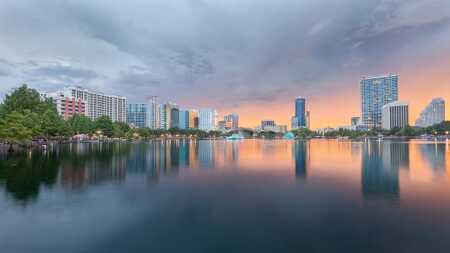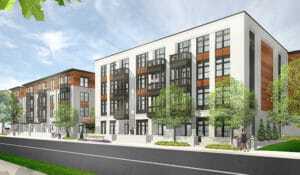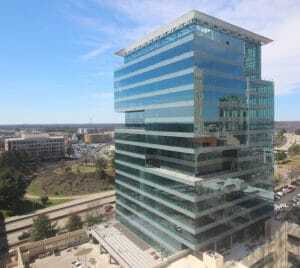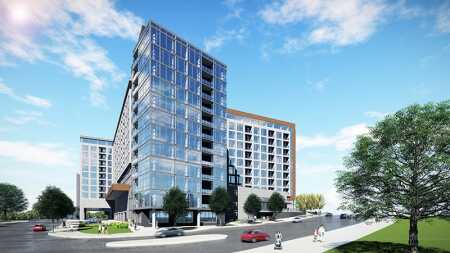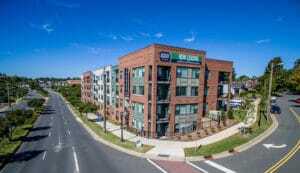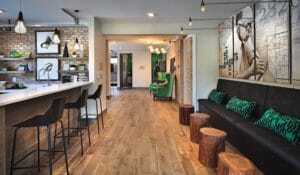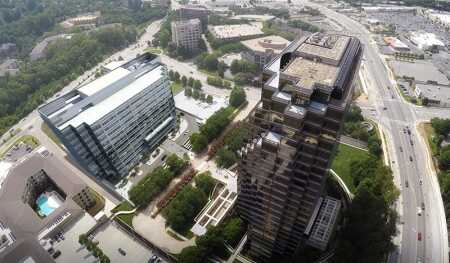
Atlanta-based architecture firm Cooper Carry designed Riverwood 200, a 320,000-square-foot (30,000 sq m) multitenant office building in the Cumberland/Vinings neighborhood of Atlanta for Highwoods Properties and Seven Oaks Company, a private real estate firm based in the city. The building opened in the first quarter of 2017. (©Cooper Carry)
For the fifth year in a row, Georgia in 2017 is expected to outperform the nation in population growth, job creation, and the rate of real estate expansion.
“Housing and real estate development will be a powerful driver of Georgia’s economy this year,” says Jeffrey M. Humphreys, director of the Selig Center for Economic Growth at the University of Georgia’s Terry College of Business.
“Powering this building surge is the state’s population gain, which will exceed the national average this year, at 1.4 percent for Georgia versus 0.8 percent for the U.S. New single-family home starts will increase by 18 percent; new multifamily starts will rise by 6 percent; existing single-family home prices will grow by 4 percent.”
“The Southeast region continues to generate steady gains in commercial real estate performance as positive employment momentum converges with generally limited development pipelines,” says John Chang, first vice president, research services, at Marcus & Millichap Real Estate Investment Services. “Tight vacancy rates remain supportive of rent growth across the majority of the region, reinforcing asset values.”
Florida
This perfectly describes the market in cities such as Miami, which remains a merchandising dynamo, with retailers capitalizing on the region’s increased consumer spending. Retail real estate completions this year are expected to reach 1.9 million square feet (177,000 sq m), the highest level since 2008.
“Over the past three years, the addition of over 3.1 million square feet [288,000 sq m] of retail space and growing demand for space has driven asking rents to new highs,” says Chang. “Several large shopping centers are coming on line, including Miami Worldcenter and CityPlace Doral.”
Buoyed by stronger economic growth, continued recovery in the state’s labor market, and rising home values, retail sales are forecast to grow at an average rate topping 6.3 percent this year, according to an analysis by the University of Central Florida (UCF). The state’s economy is expected to expand by 3.7 percent—about 1.2 percentage points higher than the average rate for U.S. growth—with Florida poised to become a $1 trillion economy by 2018.
The World Bank says that would make the state’s economy the 16th largest in the world, reports Sean Snaith, director of the UCF Institute for Economic Competitiveness.
“Florida’s labor force is expected to increase an average of 1.9 percent each year through 2019, with payroll job growth forecast to average 2.6 percent a year,” Snaith says. “Housing starts are expected to be 128,800 in 2017, increasing to 146,400 in 2018 and 160,400 in 2019.”
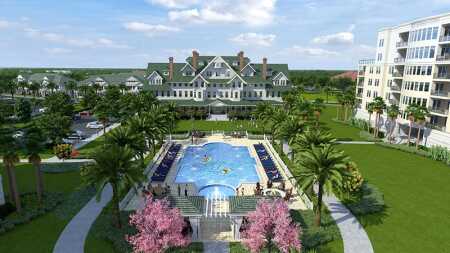
St. Petersburg–based real estate firm JMC Communities is redeveloping the Belleview Biltmore site in Belleair, Florida. The project, Belleview Place, will include a restored version of the original 1897 Henry Plant hotel, surrounded by luxury condominiums and carriage homes. (©Chris Powers, Max Wave Media)
In Broward County, the state’s second-most-populous county after Miami-Dade, employers are hiring at a steady clip, fueling demand for office space that will lower the vacancy rate and drive rent growth. Jacksonville will have another year of job creation in excess of the U.S. rate of growth, according to Chang, with favorable demographics reinforcing the city’s vigorous commercial real estate market. Chang forecasts more than 3 percent employment growth this year in Jacksonville, outpacing the national average. “The healthy job market is driving relocations to metro Jacksonville and is contributing to the creation of roughly 11,000 new households annually,” says Chang.
Orlando, which has consistently been a leader in job growth, continues its economic expansion via its rapidly developing technology sector, says Thomas C. Chatmon Jr., executive director of the Orlando Downtown Development Board/Community Redevelopment Agency.
“Building upon the success of downtown Orlando’s digital media industry is Creative Village, a 68-acre [28 ha], one-of-a-kind location for high-tech companies and 21st-century education,” Chatmon says. “Centered [on] education and a technology cluster, Creative Village will be one of the largest transit-oriented developments in central Florida, significantly expanding major universities in downtown Orlando, including the University of Central Florida and Valencia College.”
The eds and meds (education and medical) sectors of the state continue to grow elsewhere, too. UCF is now one of the largest universities in the United States in terms of undergraduate enrollment, points out Charles L. “Butch” Charlan, principal and partner of CBA Architects in Maitland.
“Other educational institutions throughout the metropolitan area are driving the development of urban nodes, including Seminole State College, which now serves 30,000 students at four campuses,” he says.
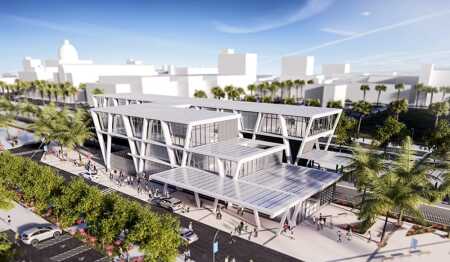
All Aboard Florida is developing a two-acre (0.8 ha), 60,000-square-foot (5,600 sq m) station in West Palm Beach for its Brightline higher-speed train service scheduled to link Miami, Fort Lauderdale, and West Palm Beach later this year. The West Palm Beach station will connect with the neighborhood’s existing vehicle, trolley, and pedestrian networks. (Brightline)
Lake Nona Medical City, a 650-acre (263 ha) health and life sciences park being developed in Orlando, is already home to the UCF College of Medicine and the Burnett School of Biomedical Sciences, the University of Florida, Valencia Community College, Sanford-Burnham Medical Research Institute, Nemours Children’s Hospital, and the U.S. Department of Veterans Affairs Medical Center, Charlan adds.
“With these institutions comes the need for various types of housing, including single-family detached, townhomes, garden-style apartments, luxury urban units, and high-density affordable multifamily, including micro apartments,” he says.
Several high-rise and mid-rise projects have recently been completed in the area, including the Sevens, a mixed-use, nine-story, 333-unit multifamily development with 8,500 square feet (790 sq m) of retail space on 2.6 acres (1 ha). In addition, the 293-unit, five-story Maitland Station—an urban infill multifamily project designed by CBA Architects and located at one of central Florida’s Sunrail stations—is among the developments now under construction.
With numerous construction projects under way in central Florida—including a $2 billion reconstruction of Interstate 4, the $1.8 billion terminal expansion at the Orlando International Airport, the new Major League Soccer stadium downtown, and the new Volcano Bay water park at Universal Studios Orlando Resort—construction costs are increasing, notes Charlan. “The competition for skilled labor has sent costs spiraling,” he says.
Though primarily known for its traditional industries of agriculture, development, and tourism, Florida continues to diversify its economy into the medical, marine, and finance sectors.
“In West Palm Beach, we have the growing Flagler Financial District, which now includes 233 financial firms ranging from general services, accounting, insurance companies to hedge-fund management and private equity firms,” says Christopher Roog, director of economic development for the city. “We also have a mega-yacht retrofit facility servicing 150-foot [46 m] yachts and a growing medical industry with three hospitals.”
West Palm Beach has more than $2 billion in development in the pipeline, including 1,000 residential units downtown that are expected to come on line in the next two years. “The downside of all this is that Class A office space is full,” he says, “and there is a footrace to see which new office building gets out of the ground first.”
On the other side of the state, St. Petersburg is prospering, thanks to the growing University of South Florida St. Petersburg and the expansion of health services, including Johns Hopkins All Children’s Hospital.
“Because of its strong economy, St. Petersburg is seeing more mixed-use development—residential, retail, office, and hospitality,” says J. Michael Cheezem, chief executive officer of JMC Communities, a St. Petersburg–based real estate development firm. “Two recently completed infill condominium developments include Rowland Place in downtown St. Petersburg and Victoria Place in Dunedin.”
JMC is working on the redevelopment of the Belleview Biltmore site in Belleair. “It is being transformed into Belleview Place, which will include a restored version of the original 1897 Henry Plant hotel as the centerpiece, surrounded by luxury condominiums and carriage homes,” says Cheezem. “Demand for residential is very strong.”
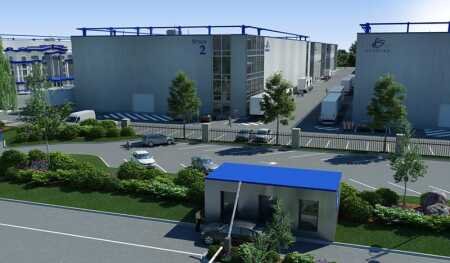
To meet the needs of the state’s expanding film industry, Three Ring Studios is constructing in Covington, Georgia, a 160-acre (65 ha) soundstage development with three campuses, a back lot, and Georgia’s first video game–development campus. The $100 million development is expected to open at the end of 2018 and could provide up to 1,700 jobs, officials say. (©Newton County Office of Economic Development)
Georgia
As noted, population growth is driving demand for development in Georgia. “Builders are working to boost retail supply as vacancies continue to tighten,” says Chang. “Through the end of 2016, the Atlanta Metro vacancy rate has fallen 400 basis points from the ten-year high and will drop further this year to 6.4 percent. Larger shopping centers with necessity retailers, including grocery stores, are popping up across the market to serve the growing number of households.”
He says much of the new retail development is in Gwinnett County and the submarkets in south Cobb County and along Georgia State Route 400, located in the northern part of the Atlanta metro area and a major conduit to Dunwoody and the northern suburbs. “Recent new projects include the 244,000-square-foot [23,000 sq m] addition to Dawson Marketplace, a shopping center in the Georgia 400 submarket anchored by a Kroger grocery store,” says Chang.
Employers in Atlanta will increase the city’s workforce by 68,000 employees—2.5 percent—this year, Chang says. “Companies including Comcast, Equifax, State Farm, and Lincoln Financial are enlarging their footprints and adding hundreds of new jobs to the Atlanta office market,” he notes. “Nearly 4.5 million square feet [418,000 sq m] of office space is under construction, with completion dates scheduled over the next two years.”
Fortune 500 companies are locating innovation centers in the Atlanta region to be near the engineering and information technology talent produced by the Georgia Institute of Technology and other institutions of higher learning, says James J. Collins, senior vice president/regional director at engineering and planning firm Thomas & Hutton.
“Proximity to Hartsfield-Jackson Airport and the area’s world-class educational institutions is important,” says Collins. “Much of this talent is choosing to live in urban areas such as Atlanta’s Midtown and the Old Fourth Ward.”
Atlanta’s education institutions provide a huge advantage for recruiting top talent, agrees Bill Halter, principal with Atlanta design firm Cooper Carry.
“Georgia Tech and Emory [University] are expanding their campuses in innovative ways to lure the best and the brightest,” Halter notes. “Integration into the mixed use of urban street life is a real positive for postgraduate candidates looking to broaden their lives and work lifestyle. Corporate users recruit and hire from this talent pool.”
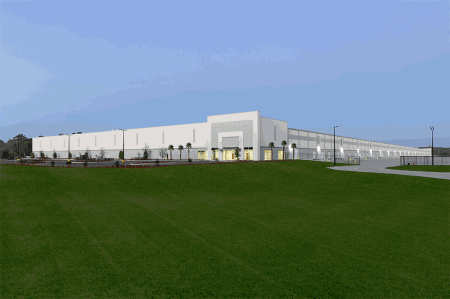
Thomas & Hutton provided civil engineering, surveying, and planning services for the recently completed 1.1 million-square-foot (102,000 sq m) distribution center on 145 acres (59 ha) in Port Wentworth, Georgia. Built for JLA Home, the project was developed Panattoni Development Company. (Wakefield Beasley & Associates)
Cooper Carry recently completed the first phase of Park Center, a transit-oriented development in Dunwoody with State Farm as a major tenant, and Riverwood 200, a multitenant office building in the Cumberland/Vinings neighborhood. “Park Center has set the stage for the greater walkability of the new city of Dunwoody with street-edge retail and a direct connection to MARTA [Metropolitan Atlanta Rapid Transit Authority],” he adds.
Further contributing to Georgia’s strong economic outlook is its expanding film industry.
“The film business in Georgia has an estimated economic impact of $7 billion, trailing only California and New York in movie production,” says Collins. “This is resulting in new development. In Covington, Three Ring Studios is constructing a 160-acre [65 ha] soundstage development with three campuses, a back lot, and Georgia’s first video game–development campus, that is projected to open at the end of 2018.”
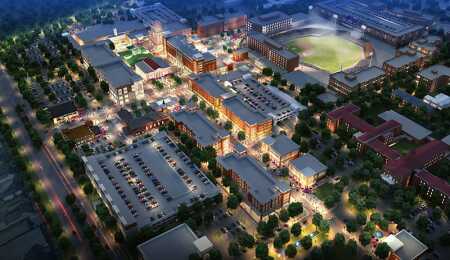
Greenville-based Hughes Development Corporation is revitalizing the centuries-old former South Carolina Department of Mental Health campus in downtown Columbia. Beau Welling Design was a member of the planning team for the new mixed-use development, BullStreet, which will provide an extension of the Columbia downtown grid, incorporating vibrant streets, public plazas, a 20-acre (8 ha) urban park, and an 8,500-seat, $37 million minor league baseball stadium. (©Hughes Development Corporation)
The Carolinas
Job growth is solid in the major metropolitan areas of North and South Carolina, with large metro areas accounting for most of the growth in the two states. Charlotte and Raleigh, North Carolina, and Charleston, South Carolina, rank among the fastest-growing metro areas in the country, says Mark Vitner, managing director and senior economist at Wells Fargo Securities in Charlotte.
“This past decade has seen a move back into the urban centers that has benefited the Carolinas’ larger MSAs [metropolitan statistical areas] the most,” he adds. “Young people are flocking back into the cities, and businesses are moving back toward the city center in order to attract those workers.”
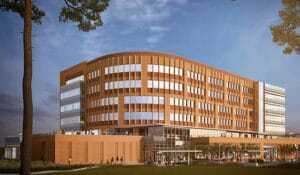
Durham, North Carolina–based Duda|Paine Architects designed the 190,000-square-foot (18,000 sq m) RTI International Headquarters in Research Triangle Park, North Carolina. Construction of the building, which started in October 2016, is expected to be completed in January 2018. (©Duda|Paine Architects)
Employment in North Carolina is expected to increase 2.3 percent this year and personal income by 4.4 percent, Vitner says. New single-family home starts will expand by 9.5 percent, but following several years of strong gains, multifamily housing starts in North Carolina remain essentially flat. Employment in South Carolina will rise 2.7 percent and personal incomes by 4.7 percent, with new home starts up 7.7 percent and multifamily starts rising 2.5 percent.
“The Carolinas are being driven by a combination of expansions by new industry into the state and some revival in traditional sectors, including textiles and furniture,” adds Vitner. “Retirees moving to the region are helping drive new home construction and growth in health care and professional services. South Carolina continues to benefit from aggressive economic development efforts. Manufacturing activity has held up solidly, with the automotive sector and aerospace industries leading the way.”
Out-of-state capital is flowing into the Carolinas, says Chang.
“Investors are drawn by more affordable entry costs and the potential for higher returns than are available in their home markets,” he says. “The increasing supply of new multifamily properties near downtown cores is keeping institutional investors active. First-year returns in this tier of the market typically begin in the 5 percent range in Charlotte, Raleigh, Greensboro/Winston-Salem [in North Carolina], Greenville/Spartanburg, Columbia, and Charleston [in South Carolina].”
In the Charlotte city center, an estimated 5.3 million square feet (492,000 sq m) of office space, more than 775,000 square feet (72,000 sq m) of retail space, 9,725 housing units, and 2,600 hotel rooms are either under construction or planned, says Jon Wilson, principal at Raleigh-based consulting firm Kimley-Horn.
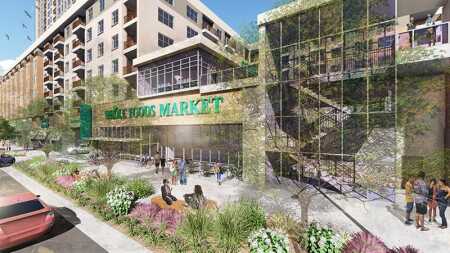
Crescent Communities’ mixed-use development Stonewall Station, designed by the Preston Partnership in collaboration with LandDesign, is under construction in a historically underpopulated area of Uptown Charlotte. The project includes a 12-story, 115-unit multifamily structure and a five-story, 330-unit apartment building, plus a vertically integrated Whole Foods Market and 15,000 square feet (1,400 sq m) of retail space—all one block from the LYNX Blue Line light rail. (©Landdesign)
Kimley-Horn is involved with a number of developments, including Atlanta-based Portman Holdings’ 19-story, 370,000-square-foot (34,000 sq m) 615 South College, which is scheduled to be completed early this summer.
“The city continues to be a hot spot for a highly educated and skilled workforce—some 17,500 new degreed residents move to Charlotte each year—and improved mobility will play a role in catalyzing future growth,” Wilson says. Later this year, the Lynx Blue Line extension will be completed, allowing people to travel on light rail from Interstate 485 in southwest Charlotte through Uptown to the University of North Carolina–Charlotte in the northeast, he says. The city also broke ground in mid-January on the second phase of the CityLynx Gold Line streetcar.
Walkable urban and mixed-use communities are definitely on the rise in many of the state’s cities, says Gary Cline, president and managing principal at Cline Design Associates of Raleigh.
“As our area rapidly grows, more people are seeking residency in urban cores and mixed-use communities where they can walk or bike to work, dining, and retail,” Cline says. “The Research Triangle office market has also made a large comeback, with less than 10 percent overall vacancy. Some submarkets like downtown Durham report less than 1 percent vacancy in Class A space.”
Demand is strong for mixed-use developments such as Kane Realty’s Smokey Hollow–Peace Street mixed-use project in Raleigh, which will have 434 multifamily units and 61,000 square feet (6,000 sq m) of retail space, with estimated completion in 2019. The project was designed by Cline Design. Another project in downtown Durham scheduled to begin construction later this year is Northwood Ravin’s Van Alen, which will have 418 units in 12 stories.
However, though construction is moving at a record pace now, that tempo is predicted to ease.
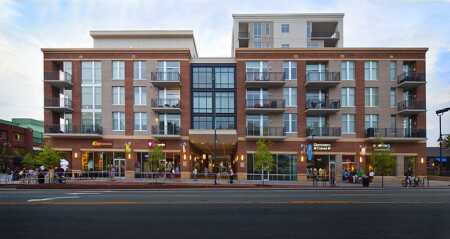
The 140 West Franklin development in Chapel Hill, North Carolina, designed by Cline Design, includes 140 luxury condominiums with 35,000 square feet (3,300 sq m) of ground-floor retail space and two stories of below-grade parking. The development, completed in 2013 as one of the first condo projects in the region following the 2008 economic downturn, was planned to meet the city’s sustainability guidelines. (©Mark Lamkin Photography.)
“As the markets mature, demand is expected to slow,” Cline says. “Real estate development in the region will moderate, although there are little signs of a slowdown at present. Construction financing is becoming more difficult, which slows funding for projects. Sharply rising construction costs and municipal regulations are making it more challenging to design feasible projects today.”
In South Carolina, Greenville and Columbia, the capital, are experiencing increased real estate activity, particularly with mixed-use developments.
“In Greenville, Centennial American Properties is transforming the city block that is currently home to the Greenville News into Camperdown, a mixed-use development with historic ties to the former textile mill that once was located there,” says Beau Welling, founder and chief executive officer of Beau Welling Design, a design and land planning firm. “We’ve been involved in that project since its initial conceptual stages three years ago.” Camperdown will include office space, multifamily units, condominiums, a hotel, and retail space, as well as a public plaza.
In downtown Columbia, Greenville–based Hughes Development Corporation is repurposing the centuries-old former South Carolina Department of Mental Health campus. Now called BullStreet, it is envisioned as a mix of office, retail, and residential space and will include one of the state’s first urban gigabit communities—offering one gigabit-per-second service, about 100 times faster than the average fixed high-speed internet connection.
“The history and character of the site is being preserved through the adaptive reuse of many of the existing buildings, which date back to the 1800s,” says Welling. “Hughes is transforming the property into a mixed-use development that includes an extension of the Columbia downtown grid, incorporating vibrant streets, public plazas, a 20-acre [8 ha] urban park, and an 8,500-seat, $37 million minor league baseball stadium.”
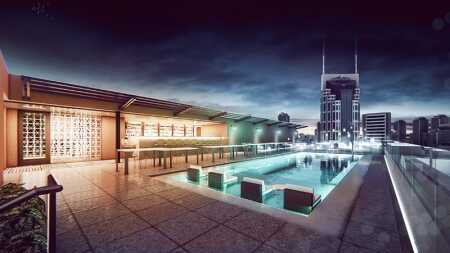
New Orleans–based HRI Properties, which redevelops historic urban centers, is renovating Nashville’s historic James Robertson Hotel. ESA is the architect for the 13-story, 125,000-square-foot (12,000 sq m) renovation, which is scheduled to open this fall. Revitalization of the property, which originally opened in 1929, will incorporate 21st-century amenities, including a rooftop pool/bar and a fitness center. Construction started in July 2016. (©ESA)
Tennessee

Grubb Properties’ 203-unit Link Greenwood multifamily development, located in the Glenwood South entertainment district near downtown Raleigh, was completed in spring 2016. It was built at a 1.3-acre (0.5 ha) infill site that included a one-story, 5,000-square-foot (465 sq m) building. (©Sterling E. Stevens Design Photo)
Adaptive use is also a major force in Tennessee’s real estate sector. Memphis is renovating, retrofitting, refurbishing, recycling, and reusing its downtown core, says Frank Ricks, principal at local architectural, planning, and interior design firm Looney Ricks Kiss (LRK). St. Jude Children’s Research Hospital last year announced plans for a multibillion expansion in the city—including housing and research facilities plus more than 1,000 new jobs—which is expected to double the hospital’s annual $2 billion–plus economic impact in the community, Ricks says.
In conjunction with the St. Jude’s expansion, one of the major undertakings in the city is the planned redevelopment of the Pinch District, a 12-block area on the north edge of downtown, Ricks says.
“The goal is to create a walkable mixed-use urban district that builds upon the history and character of the area and reinforces connections to downtown Memphis assets, including St. Jude’s, the Cook Convention Center, Bass Pro at the Pyramid, the Uptown District neighborhood, and the Mississippi riverfront,” he says. “Possible development includes multistory mixed use with office, retail, and residential, as well as a hotel, a pedestrian bridge, and underpass lighting improvements.”
Over the next decade, Tennessee’s population is expected to grow at a rate of 1 percent per year, matching the forecast population growth of the nation, says Matt Murray, associate director of the Boyd Center for Business and Economic Research at the University of Tennessee in Knoxville.
“The state is expecting 1.4 percent job growth and an unemployment rate under 5 percent this year,” he adds. “Nominal personal income in Tennessee should increase 4.5 percent this year, followed by 5.1 percent growth in 2018. Nonfarm jobs should be up 1.4 percent this year and 1.2 percent next. Manufacturing will see job gains of less than 1 percent in both years.”
Nashville’s medical sector continues to prosper. The city is a health care center for the country, and more than half of the investor-owned hospital beds in America are run by Nashville-based companies, says Ron Lustig, principal at Nashville design firm ESa. “Nearly 400 health care companies have operations in Nashville,” he notes. “Globally, Nashville’s health care industry generates more than $78 billion in revenue and more than 500,000 jobs.”
In addition to health care, high tech is expanding in the city, driven by the health care industry and providing everything from medical devices to patient care systems. “Asurion, a technology protection services company, just announced it plans to grow its Nashville headquarters by 500 jobs over the next five years, and there is need for small, office-like incubator spaces for startup companies,” Lustig says.
ESa is designing a number of projects in the Nashville area, including the Pearl Street Development, a workforce housing community in an emerging redevelopment area that will provide efficiency-type living spaces at reasonable rental rates. “Nashville’s multifamily and office sectors will continue to grow for the rest of this year, thanks to a vibrant economy,” he adds.
Absent an unexpected financial or economic shock, the U.S. Southeast is expected to prosper this year and for several years to come.
Mike Sheridan is a freelance writer based in Richmond, Virginia.

